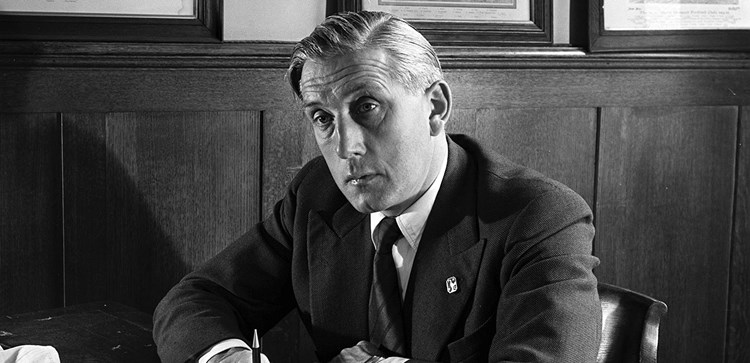
History | Arthur Rowe and the Hungarian influence on our 'push and run' football
Wed 02 October 2024, 13:30|
Tottenham Hotspur
The role of Arthur Rowe at our great club can never be underestimated.
Spurs through and through, born in Tottenham in 1906, Rowe achieved the dream of both playing and managing his boyhood team. He made 201 appearances for us in all competitions between 1929-1939, then, as manager, led us to our first Division One title in 1950/51, a season after his team stormed back into the top flight via the Division Two title in 1949/50.
But it was more than that.
If we're a club famed for an attacking, free-flowing style of football, then much of that philosophy stems from Arthur Rowe - and his time in Hungary.
After retiring as a player in 1939, Arthur was invited to Hungary via a friendship with Hungarian sports journalist, Laszlo 'Lotzi' Feleki to work with high school and college students in Budapest. Feleki was Arthur's translator during that period before he returned to England on the outbreak of the Second World War.
Hungarian coaches would come and watch Arthur's sessions in Hungary, as did key players, including all-time great Ferenc Puskas, as Hungary became the best team in Europe in the 1950s. Indeed, the football that took us to back-to-back titles was seen in full effect on the world stage three years later when the Marvellous Magyars memorably beat England 6-3 at Wembley and then 7-1 in Budapest in 1954. These were, according to the BBC, 'matches that started a revolution' in English football.
Seventy years on, we're preparing for our first competitive match against Hungarian opposition as we face Ferencvárosi TC in Matchday 2 of our UEFA Europa League league phase in Budapest on Thursday evening (5.45pm UK).
To mark Arthur's role in our history, including his time in Hungary, here is a special excerpt from our Tottenham Hotspur Opus book of 2007, explaining that Hungarian influence and the birth of 'push and run'...
New world
From the Tottenham Hotspur Opus
The post-War years...
Arthur Rowe arrived as manager at White Hart Lane at the end of the 1948/1949 season, having impressed the club’s directors with his forward-thinking ideas at non-League Chelmsford City. Certainly he came with an impressive CV. He was born just around the corner from White Hart Lane. He had also played for Spurs and even as a player he was known to analyse games and study tactics. It was clear he held ambitions for a coaching role once his playing career was over.
The real making of Rowe, however, was his move to Hungary before the outbreak of war. It was there that he studied a very different style of football from the one played out in England. Teams such as Arsenal in the 1930s, and Newcastle and Wolves in the 1950s, would thrive on playing long passes out of their own half to flying wingers and barnstorming centre-forwards, often bypassing the midfield.
Rowe’s philosophy was to employ the traditional passing style Spurs had used when he was a defender at the club, and reminiscent of the swift and accurate football he witnessed in Hungary. “Our style was basically the method of Spurs football taught down the years,” he said. “But with variations. Tottenham had always tried to play football to entertain. When you can get both – entertainment and effectiveness – you are on the right road.”
His philosophy became known as push-and-run. “You often see something like our style happening in a match,” he said. “A side suddenly stringing together short, quick passes and players moving intelligently to give and take them … I took our style back to the streets, the way we played it as kids – off the kerb, off the wall, taking the ball at different angles, enlisting the kerb as a team-mate who let you have the ball back immediately after you had played it quickly … the quicker the better.”
It was to transform not only the fortunes of Tottenham Hotspur, but the English game on a wider level. Rowe’s influence was immense – he was the manager who inspired both Bill Nicholson and World Cup-winning manager Alf Ramsey. To do this, though, Rowe relied on the personnel already at his disposal. Nicholson was a long-standing member of the talented team he had inherited while Ramsey had just been signed from Southampton. Together they quickly forged an understanding.
But there were plenty of very good players at the club when Rowe arrived. Ted Ditchburn was on his way to a record unbroken sequence of appearances, and considered one of the best goalkeepers in the country. Big defender Harry Clarke was signed from Lovell’s Athletic in Newport, south Wales, although he was a Londoner, and left-back Charlie Withers was another local lad. The half-backs Nicholson and Burgess proved an effective force (with Nicholson operating in front of Ramsey), and the forward line bristled with talent: Les Medley on the left wing, Sonny Walters on the right, Duquemin in the middle and inside-forwards Eddie Baily and Les Bennett.
Baily maintains that Rowe did not have to introduce any revolutionary tactics into the team. They were talented players who all liked quick passing and movement, and were good ball players.
“Contrary to rumour, he never really coached us or showed us what to do,” Baily says. “He thought there was no need, so we did a lot of it ourselves and there was a lot of natural telepathy between the players. We simply never allowed the ball to stop. There were changing room sayings like, ‘A rolling ball gathers no moss’, and ‘Make it simple, make it quick’. Those things knitted us together as a team and had us all thinking the same way.”
With Rowe encouraging his team to play their natural game, Spurs took the Second Division by storm in 1950. Leon Ruskin was a schoolboy supporter at the time. He recalls the buzz created by Rowe’s side: “The arrival of Arthur Rowe was extremely well received,” he says. “One could see immediately that Rowe knew what he was doing, and the football we were seeing was what the fans wanted.
“They had some outstanding players who formed the nucleus of the side. But before Rowe arrived, many matches were drawn, which was very frustrating. Then we started to see matches ending in a result, and the football was attractive, with man-to-man passing. The ball never travelled more than 15 yards because Rowe firmly believed in the importance of keeping possession. You passed the ball and ran into a space to receive a pass back, and the ball was pinging around all over the field. The spirits were certainly up.
“I was young, but my recollection was Rowe making it clear what his philosophy was. It had a big psychological effect on all the other sides because nobody really knew how to contend with it. They were chasing shadows a lot of the time. It took about two or three years for teams to get to grips with it.”
The stylish manner in which the side set about their promotion push was in evidence right from the outset. Spurs kicked off their campaign with impressive back-to-back 4-1 victories over Brentford and Plymouth Argyle. Meanwhile, the slip-ups, when they came, were nevertheless entertaining encounters. The rare defeats, such as the 3-2 loss against Blackburn at White Hart Lane, were dappled with exciting football.
The team were to learn from that defeat, too. They did not experience another in the league until January, an incredible run which was to lay the foundations for their eventual promotion. Spurs won 2-0 at Plymouth on August 31 before embarking on a sequence of 22 league matches unbeaten, a run which was to end with a 3-0 defeat at the hands of Leeds United on January 14, 1950.
From early September onwards, promotion, and promotion as champions no less, never seemed in doubt. Spurs were not removed from the top of the table for nine months. Their nearest rivals finished nine points adrift. The statistics also highlight the Spurs claim to league superiority: they scored 81 goals – more than any other team – and conceded just 35, which was less than any other.
The key to success, Rowe said, lay in his team rather than the tactics. “They were not just good players,” he said. “I took some marvellous players. Eddie Baily: a natural one-touch player. I never saw a man who could play a moving ball either way and with either foot as quickly and as accurately. Then there was the skipper, Ronnie Burgess – brilliant, a great player. And I don’t use that word easily. I wanted the ball moved at speed from the midfield and that is what this priceless pair did for me.
“Then there was Alf Ramsey, who gave us momentum from the back. There was no finer competitor than Ted Ditchburn in goal, nor did I think there was a better goalkeeper to be found. They played as you wanted them all to play. They were the ones who used their abilities to the full.”
But it was not just the league performances that so impressed during Rowe’s trailblazing campaign. Spurs had faced First Division opposition during The FA Cup and at no stage had they look outclassed.
After defeating Stoke City in the third round, Spurs thrashed a Sunderland side which was to finish as the third-best team in the country. Goals from Les Medley and two apiece for Sonny Walters and Bennett in a stunning 5-1 victory made it one of the most memorable days of the campaign in front of more than 66,000 fans.
Even when the cup run was ended in the fifth round by a strong Everton side at Goodison Park, it was only through a hotly-disputed penalty. The best teams in the land were well aware of what was coming the following season.
As were the fans. Rowe’s swashbuckling football soon had the crowds flocking to White Hart Lane. Those who had grown disillusioned with season after season in the second tier found much to cheer. So much so, that Tottenham Hotspur’s average attendance for the 1949/1950 season was an impressive 54,405 – the highest in the Football League. North London rivals Arsenal could only come close with an average of 51,381. Spurs’s biggest gate of the season was 70,305 for a match with Southampton on February 25. More than a million spectators visited the ground during this momentous campaign.
“Arsenal won the cup in 1950, but they were very much the secondary side in London,” Ruskin says. “Spurs were able to look down their noses at them for the first time in decades. There was tremendous excitement during that season and the press were getting very excited as well. The feeling was that Spurs just couldn’t be beaten.
“Fans back then were all working class people who stood on the terraces. There were no executive boxes. Soccer was the sport of the people. We used to stand with opposing fans and they would be just as excited by what they saw from Spurs as we were. Their team might have been thrashed, but they appreciated good football. It made you proud to hear them say, ‘What a team you’ve got!’”
First Division glory
No-one could predict quite what would happen once Spurs returned to the First Division, but there was huge excitement and anticipation around White Hart Lane.
Eddie Baily remembers: “We felt that we couldn’t get the next season started quickly enough. Remember, none of us had sampled the First Division before. We didn’t fear it, we knew we were a very good side now. But we were impatient to find out just how good.”
Perhaps the most prescient view came from Stan Seymour, one of Newcastle’s directors, who had watched Spurs demolish Leicester City at Filbert Street the previous season. He told club officials: “I have never seen anything like it. If you keep that up you’ll win the First Division Championship, let alone the Second Division.”
But Spurs’ glorious charge did not start with a bang. In fact, quite the opposite. Blackpool, with Stanley Matthews in tow, travelled to White Hart Lane for the opening day of the season and ran out 4-1 winners. Still, Spurs supporters were not too downhearted. They had seen enough to suggest the team could more than hold their own in the top flight. Ken Hamilton, a young supporter, said: “I recall the first game back in the First Division, losing to Blackpool. Stanley Matthews played such a great game it was hard not to enjoy it.”
A return to winning ways was not far off. Bolton Wanderers were beaten twice in a week (with Spurs scoring four times on each occasion) and a home victory over Manchester United was soon followed by the 3-2 defeat of Aston Villa, the first of eight straight league wins, culminating in the astonishing 7-0 thrashing of Newcastle United.
If there was one game that really confirmed the club’s First Division title credentials it was this one at White Hart Lane on Saturday, November 18, 1950. In the month prior to Newcastle‘s arrival, Arthur Rowe’s attack-minded side had slammed five goals past Portsmouth and six past Stoke City, both at White Hart Lane. Much of this attacking prowess was down to the near-telepathic understanding between Walters, Baily, Medley, Bennett and Duquemin. All five were to shine against a normally solid Newcastle defence, which included highly rated Scottish international Bill Brennan.
Baily recalls: “Our form was good going into the game because we had beaten a lot of leading teams. But Newcastle had some big names, like Jackie Milburn, in the side and we were expecting a difficult game.”
A crowd of more than 70,000 spectators witnessed the match, with thousands more being turned away from the stadium. The clamour to watch what was being described as the most entertaining team in the country was gathering pace.
Those who were in attendance that November afternoon were not to leave White Hart Lane disappointed either. The home side hit seven goals past their opponents in what seemed like wave after wave of attacking brilliance. These attacks were made more impressive by the state of the pitch, which was in terrible condition.
“Most pitches we used to play on were poor because they were often based on scrub or marsh land,” says Baily. “With the big heavy boots we used to wear and heavy footballs we used to play with, it was very different from nowadays. But back then, we had nothing to compare it to, so we just got on with it.
“It certainly influenced the way we played. If passes were being held up in the mud, players would have to run back to retrieve the ball. So the key to the way we played was having players who could hit the ball clean over the surface.”
The scoring was opened after just five minutes when Les Bennett headed home following an exquisite move involving Baily, Medley and Duquemin, which left the visiting defence startled. It proved to be a sign of things to come.
Baily, off the back of a fine performance for England against Wales, soon made it 2-0, using his close control to skip past defender Joe Harvey. When Medley made the score 3-0 on 31 minutes, the floodgates seemed ajar. They flew open with Medley’s second – and his side’s fourth – just after half-time. Then the prolific Walters rifled home from long range not long after the hour mark.
“We swept them aside from the start – just steamrollered them,” says Baily. “As the goals started going in, our confidence just kept rising. Everything we tried seemed to come off. We started doing some outrageous things and they were coming off. The Newcastle players were shell-shocked in the end.”
Indeed, Newcastle had little response. With the score at 5-0, the game was as good as over. Spurs had been breath taking, but something was missing from the afternoon – a strike from the prolific Duquemin.
Having had a hand in nearly every goal, the Channel Islander would have counted himself unlucky not to have made the scoresheet. Journalist Tony Horstead later wrote: “It is almost invidious to single out a Spurs man for particular praise, but I feel that centre-forward Len Duquemin, the only man in the attack not to score, deserves the honour.”
After Medley completed his hat-trick with Spurs’s sixth 12 minutes from time, Duquemin provided his ultimate contribution, forcing the back-tracking Newcastle defender Bobby Cowell to slip under pressure and handle the ball in the penalty area. Alf Ramsey stepped up to complete the rout.
Newspaper reports the following day were full of praise. Writers who had witnessed Spurs’s progress through a division they had only just re-joined were unanimous in their praise. Horstead wrote: “The result was a soccer feast. On this showing I see no reason why Spurs, no longer the team of the year, but rather the team of the century, should not win all the honours and finish up by representing England en bloc.”
What made such a resounding performance even more poignant was that Spurs had achieved such a feat without the aid of the inspirational Burgess. He was injured for this game, though it mattered little. He was deputised by the young Colin Brittan, who hardly placed a foot wrong at left-half.
“Colin was a nice lad and a good, run-of-the-mill player,” says Baily. “He might have had a decent career at another club, and he could have played the game of his life against Newcastle - but he would never
have replaced Ronnie.”
Although Spurs lost their next game, 3-2 at Huddersfield Town, it was quickly followed by another seven-game unbeaten run as 1950 drew to a close. Huddersfield also put Spurs out of The FA Cup in the third round in early January 1951, but at least that left Rowe’s men to concentrate on the league. Eight wins in the next 12 games put Spurs in the driving seat, as they suffered only two League defeats between mid-January and the end of the season, to Burnley and Huddersfield.
The title was finally clinched on April 28, 1951, with a narrow 1-0 victory over Sheffield Wednesday at White Hart Lane. Duquemin scored the goal, richly deserved for a player who rarely got his full share of credit.
For the first time in their history, Tottenham Hotspur were Division One champions...
Words | Gerry Cox
Learn more on Arthur Rowe with this profile, also from the Opus.








